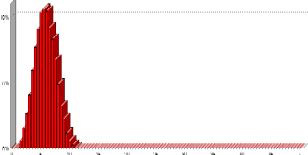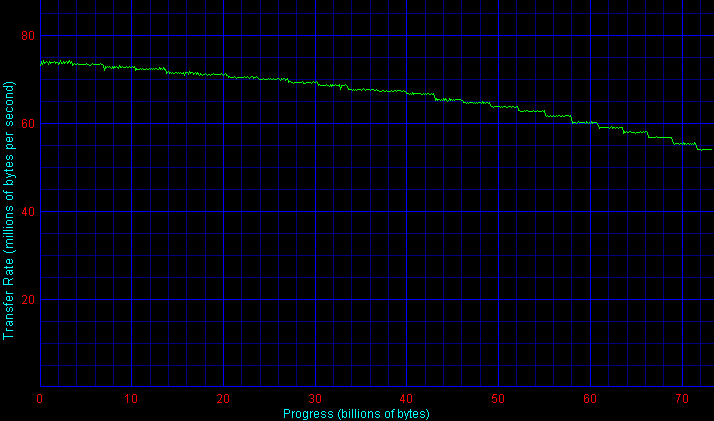|

The firm joins contenders Fujitsu and Hitachi in the race to produce the world’s fastest drive. Like the Cheetah 15k.3, the Atlas 15k features 18-gigabyte platters to yield configurations of 18, 36, and 73 GB. Maxtor specifies average random seek times at an ambitions 3.4 milliseconds on the flagship 73-gig drive and 3.2 milliseconds on the smaller units. The Atlas 15k is equipped with an industry-standard 8-megabyte buffer.

The onus is on Maxtor to best the performance brought to the table by the Cheetah 15k.3. The latter has enjoyed widespread availability for more than half a year. Maxtor (like Fujitsu, with its upcoming MAS3735), has had six months of additional latitude to tune the Atlas 15k’s performance. Read on to see whether the Atlas has what it takes.
Low-Level ResultsFor diagnostic purposes only, StorageReview measures the following low-level parameters: Average Read Access Time– An average of 25,000 random accesses of a single sector each conducted through IPEAK SPT’s AnalyzeDisk suite. The high sample size permits a much more accurate reading than most typical benchmarks deliver and provides an excellent figure with which one may contrast the claimed access time (claimed seek time + the drive spindle speed’s average rotational latency) provided by manufacturers. WB99 Disk/Read Transfer Rate – Begin– The sequential transfer rate attained by the outermost zones in the hard disk. The figure typically represents the highest sustained transfer rate a drive delivers. WB99 Disk/Read Transfer Rate – End– The sequential transfer rate attained by the innermost zones in the hard disk. The figure typically represents the lowest sustained transfer rate a drive delivers. |
For more information, please click here.
|
Note: Scores on top are better. |
|
|||||||||||||||||||||||||||
|
|
||||||||||||||||||||||||||
8C073L0 Average Read Service Time |
8C073L0 Average Write Service Time
|
||||||||||||||||||||||||||
With an average read access time of just 5.7 milliseconds, the Atlas 15k moves its actuator to the request’s location more swiftly than any other drive we have yet measured. Subtracting two milliseconds to account for the rotational latency of a 15,000 RPM drive yields a measured seek time of 3.7 ms- impressive in an absolute sense, but off of Maxtor’s claim by 0.3 ms. At 6.1 milliseconds, the Atlas’s measured write access time also slides in just under that of the Cheetah 15k.3 to set another record.
|
Note: Scores on top are better. |
|
|||||||||||||||||||||||||||
|
|
||||||||||||||||||||||||||
8C073L0 Transfer Rate
|
|||||||||||||||||||||||||||
The Atlas’s outer-zone transfer rate of 73.7 MB/sec does not quite measure up to that of the 15k.3. The drive, however, boasts significantly less decay as it moves inwards, bottoming out at 55.6 MB/sec to claim the top spot.
Single-User PerformanceStorageReview uses the following tests to assess non-server use: StorageReview.com Office DriveMark 2002– A capture of 30 minutes of actual computer productivity use that exactingly recreates a typical office-style multitasking environment. The applications include: Outlook XP, Word XP, Excel XP, PowerPoint XP, Calypso (a freeware e-mail client), SecureCRT v3.3 (a telnet/SSH client), CuteFTP Pro v1.0 (an FTP/SSH client), ICQ 2000b), Palm Hotsync 4.0, Gravity 2.3 (a Usenet/newsgroups client), PaintShop Pro v7.0, Media Player v8 for the occasional MP3, and Internet Explorer 6.0. StorageReview.com High-End DriveMark 2002– A capture of VeriTest’s Content Creation Winstone 2001 suite. Applications include Adobe Photoshop v5.5, Adobe Premiere v5.1, Macromedia Director v8.0, Macromedia Dreamweaver v3.0, Netscape Navigator v4.73, and Sonic Foundry Sound Forge v4.5. Unlike typical productivity applications, high-end audio- and video- editing programs are run in a more serial and less multitasked manner. The High-End DriveMark includes significantly more sequential transfers and write (as opposed to read) operations. |
StorageReview.com Bootup DriveMark 2002– A capture of the rather unusual Windows XP bootup process. Windows XP’s boot procedure involves significantly different access patterns and queue depths than those found in other disk accesses. This test recreates Windows XP’s bootup from the initial bootstrap load all the way to initialization and loading of the following memory-resident utilities: Dimension4 (a time synchronizer), Norton Antivirus 2002 AutoProtect, Palm Hotsync v4.0, and ICQ 2000b.
StorageReview.com Gaming DriveMark 2002– A weighted average of the disk accesses featured in five popular PC games: Lionhead’s Black & White v1.1, Valve’s Half-Life: Counterstrike v1.3, Blizzard’s Diablo 2: Lord of Destruction v1.09b, Maxis’s The Sims: House Party v1.0, and Epic’s Unreal Tournament v4.36. Games, of course, are not multitasked- all five titles were run in a serial fashion featuring approximately half an hour of play time per game.
For more information, please click here.
|
Note: Scores on top are better. |
|
|||||||||||||||||||||||||||
|
|
||||||||||||||||||||||||||
|
|
||||||||||||||||||||||||||
A SR Office DriveMark 2002 of 621 I/Os per second propels the Atlas 15k to record heights in desktop performance. Similarly, a High-End DriveMark of 515 I/Os per second allows to the Atlas to top Seagate’s offering. Interestingly, however, it is not enough to break the record set by the SATA Western Digital Raptor (not shown; visit the SR database to create a custom comparison).
Though it is difficult to envision many users deploying the Atlas 15k in such circumstances, those that do may rest assured that it is a top-rate performer when it comes to Windows XP bootups and a variety of games.
Multi-User PerformanceStorageReview uses the following tests to assess server performance: StorageReview.com File Server DriveMark 2002– A mix of synthetically-created reads and writes through IOMeter that attempts to model the heavily random access that a dedicated file server experiences. Individual tests are run under loads with 1 I/O, 4 I/Os, 16 I/Os, and 64 I/Os outstanding. The Server DriveMark is a convenient at-a-glance figure derived from the weighted average of results obtained from the four different loads. StorageReview.com Web Server DriveMark 2002– A mix of synthetically-created reads through IOMeter that attempts to model the heavily random access that a dedicated web server experiences. Individual tests are run under loads with 1 I/O, 4 I/Os, 16 I/Os, and 64 I/Os outstanding. The Server DriveMark is a convenient at-a-glance figure derived from the weighted average of results obtained from the four different loads. For more information click here. |
|
Note: Scores on top are better. |
|
|||||||||||||||||||||||||||
|
|
||||||||||||||||||||||||||
While the Atlas manages to consistently outperform the Cheetah in single-user measures, multi-user performance is a virtual dead heat. It is server performance that manufacturers gun for with their enterprise-class offerings. Equipped with its formidable access times, Maxtor’s Atlas 15k edges out the Cheetah 15k.3 to narrowly claim the File Server DriveMark crown. Seagate, for its part, reverses the tables when it comes to the read-heavy web server pattern.
Legacy PerformanceeTesting Lab’s WinBench 99 Disk WinMark tests are benchmarks that attempt to measure desktop performance through a rather dated recording of high-level applications. Despite their age, the Disk WinMarks are somewhat of an industry standard. The following results serve only as a reference; SR does not factor them into final judgments and recommends that readers do the same. |
|
Note: Scores on top are better. |
|
|||||||||||||||||||||||||||
|
|
||||||||||||||||||||||||||
Heat and NoiseIdle Noise– The sound pressure emitted from a drive measured at a distance of 18 millimeters. The close-field measurement allows for increased resolution between drive sound pressures and eliminates interactions from outside environmental noise. Note that while the measurement is an A-weighted decibel score that weighs frequencies in proportion to human ear sensitivity, a low score does not necessarily predict whether or not a drive will exhibit a high-pitch whine that some may find intrusive. Conversely, a high score does not necessarily indicate that the drive exhibits an intrusive noise envelope. Net Drive Temperature– The highest temperature recorded from a 16-point sample of a drive’s top plate after it has been under heavy load for 80 minutes. The figures provided are net temperatures representing the difference between the measured drive temperature and ambient temperature. For more information, please click here. |
|
Note: Scores on top are better. |
|
|||||||||||||||||||||||||||
|
|
||||||||||||||||||||||||||
With an objectively-measured idle noise of 47.6 dB/A at a distance of 18 millimeters, the Atlas 15k does not reach the floor set by the impressively-quiet Cheetah 15k.3. Nonetheless, in an absolute sense, 47 dB/A is remarkable for a 15k RPM SCSI drive- the Atlas 15k joins other SCSI drives in defining noise floors previously generated only by ATA drives. Seeks are easily audible, though they rumble away in a relatively light, hollow manner.
The Atlas reaches hits 30.8 degrees Celsius above ambient room temperature when performing under heavy loads. Anyone integrating one of these drives in a system should of course remember its 15k SCSI classification and employ an appropriate venting/cooling scheme.
ReliabilityThe StorageReview.com Reliability Survey aims to amalgamate individual reader experiences with various hard disks into a comprehensive warehouse of information from which meaningful results may be extracted. A multiple-layer filter sifts through collected data, silently omitting questionable results or results from questionable participants. A proprietary analysis engine then processes the qualified dataset. SR presents results to readers through a percentile ranking system. According to filtered and analyzed data collected from participating StorageReview.com readers, the |
Note that the percentages in bold above may change as more information continues to be collected and analyzed. For more information, to input your experience with these and/or other drives, and to view comprehensive results, please visit the SR Drive Reliability Survey.
ConclusionOverall, the Atlas 15k represents an admirable first entry into the market by Maxtor. Building on techniques refined over four generations of 10,000 RPM drives, the Atlas 15k delivers exceptional server performance that rivals and in some cases surpasses the Seagate Cheetah 15k.3. Further, when it comes to desktop performance, there is little doubt that the Atlas is numero uno. While Fujitsu’s 15,000 RPM MAS3735 lurks on the horizon, the Atlas 15k is and will remain a solid choice for all applications that require best-of-breed performance. |




 Amazon
Amazon